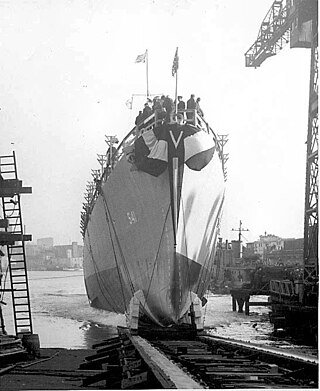
The V and W class was an amalgam of six similar classes of destroyer built for the Royal Navy under the 9th, 10th, 13th and 14th of fourteen War Emergency Programmes during the First World War and generally treated as one class. For their time they were among the most powerful and advanced ships of their type in the world, and set the trend for future British designs.
At the outbreak of the Second World War Nazi Germany's Kriegsmarine had 21 destroyers in service, while another one was just being completed. These 22 vessels – comprising 3 classes – had all been built in the 1930s, making them modern vessels. Including that final pre-war vessel, a further 19 were brought into service during the war and more were captured from opposing navies, including the Italian Navy after the Italian Armistice with the Allies in 1943.

The Admiralty type leader, sometimes known as the Scott class, were a class of eight destroyer leaders designed and built for the Royal Navy towards the end of World War I. They were named after Scottish historical leaders. The function of a leader was to carry the flag staff of a destroyer flotilla, therefore they were enlarged to carry additional crew, offices and signalling equipment, allowing a fifth gun to be carried. These ships were contemporary with the Thornycroft type leader, distinguishable by their two narrow funnels of equal height, the Thornycroft designs latter having characteristic broad, slab-sided funnels.

USS Seymour D. Owens (DD-767) was scheduled to be a Gearing-class destroyer in the United States Navy. She was named for Seymour D. Owens, a United States Navy officer killed during World War II.

USS New England (AD-32), was a planned destroyer tender of the United States Navy during World War II.

USS Sheehan (DE-541) was a United States Navy John C. Butler-class destroyer escort launched during World War II but never completed.

USS Oswald A. Powers (DE-542) was a United States Navy John C. Butler-class destroyer escort launched during World War II but never completed.
USS Groves (DE-543) was a proposed World War II United States Navy John C. Butler-class destroyer escort that was never completed.

John Crittenden Watson was an admiral of the United States Navy.

The Barnegat class was a large class of United States Navy small seaplane tenders (AVP) built during World War II. Thirty were completed as seaplane tenders, four as motor torpedo boat tenders, and one as a catapult training ship.
USS Castle (DD-720) was a planned United States Navy Gearing-class destroyer laid down during World War II but never completed. It was to be named for Guy W. S. Castle (1879–1919), a United States Navy officer and Medal of Honor recipient.
USS Hoel (DD-768) was a planned United States Navy Gearing-class destroyer laid down during World War II but never completed. The ship was to be named after William R. Hoel (1824-1879), a United States Navy officer Navy Cross recipient.

USS Abner Read (DD-769) was a planned United States Navy Gearing-class destroyer laid down during World War II but never completed. The ship was to be the second ship named for Abner Read (1821–1863), a United States Navy officer killed during the American Civil War. She was assigned the name during construction when the first Abner Read (DD-526), a Fletcher-class destroyer, was sunk by a kamikaze during the Battle of Leyte, 1 November 1944.

USS Francovich (APD-116) was a United States Navy Crosley-class high speed transport in commission from 1945 to 1946. She was sold for srap in 1965.
USS Harold J. Ellison (DE-545) was a proposed World War II United States Navy John C. Butler-class destroyer escort that was never completed.
USS Vogelgesang (DE-284) was a proposed United States Navy Rudderow-class destroyer escort that was never completed.

The Xanthus-class repair ships were a class of five auxiliary ships built for the United States Navy and Royal Navy. Ships of the class served in a diverse range of environments in varying capacities during both World War II and the Korean War. Xanthus-class ships were in commission between 1945–1955.

Ateliers et Chantiers de la Loire (ACL) was a French shipbuilding company of the late 19th and early 20th century. The name translates roughly to English as "Workshops and Shipyard of the Loire".
SS William L. Watson was a Liberty ship built in the United States during World War II. She was named after William L. Watson, the first Agricultural Agent for Duval County, Florida, also active in the Florida 4-H club.

USS Percival (DD-452) was an experimental United States Navy destroyer who was never laid down and cancelled in 1946.












